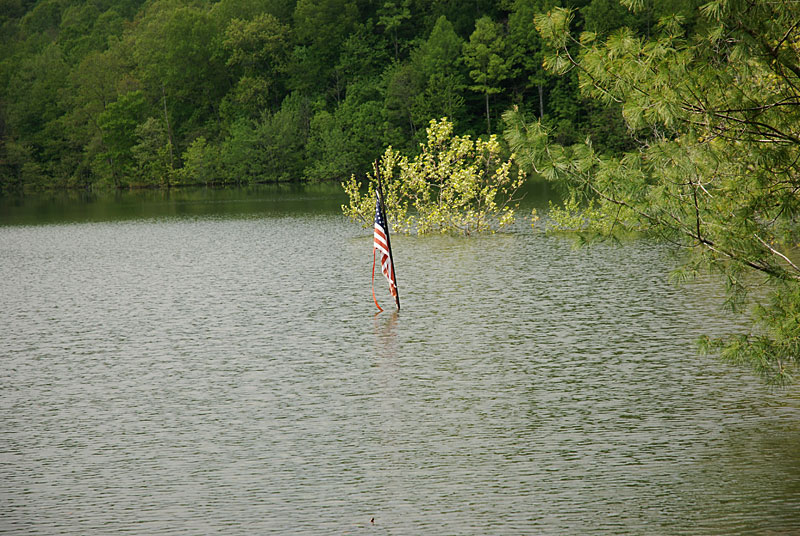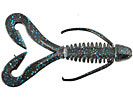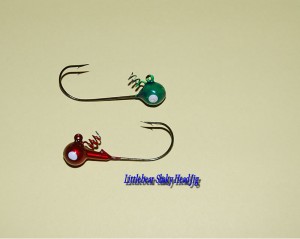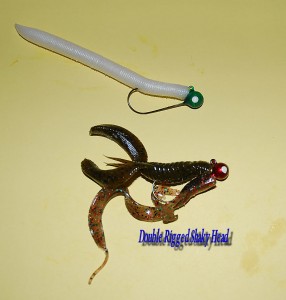By Chris Erwin
With a quick look around the Bluegrass state, this spring has been a high water event that many will be talking about for a long time. Fishing trips have been delayed or canceled because of high dirty water. Streams have been swift and trash filled as creeks flush out trash that normally never sees water.

Since none of this is anything any of us can do anything about the question remains, what this has done to the fishing and is there anything we can do to mitigate the effects of all the flooding.
Let me put this in simple terms “learn to fish creature baits” I’ll be honest. This is not my favorite way to fish, but if you want to learn how to defeat dirty high water this is a must learn tactic you need to have in your bag of tricks.

Before we get into talking about creature baits let’s define them a little better so you understand exactly what we are talking about. To sum it up and a few words we are talking about soft plastic creature looking baits that are fished with both jigs and weightless rigs, this also includes baits like the Jerk worms, and shaky head rigs.
These types of baits shine in flooded stained water, they can be fished with a merited of retrieves including vertical flipping, weightless slow dropping, and traditional lifting and dragging, all designed to give the impression of creatures in the water either struggling or foraging.
As we get into “how to” and “where to” fish these baits, we should talk a little about what happens to lakes and rivers that get flooded, so we can understand how you can put together a pattern of fishing that will produce under these extreme conditions.
As lakes and rivers start to flood; there are a few predictable things that happen. “Run in” areas flush in bait from creeks and run off areas in the form of everything from minnows to bugs and worms. In the first stages of a high water event, these areas can be highly productive fishing “run in” locations.
These areas can have a brief window of high success as waters continues to flood and become torrent fish will begin to move into areas of what has been coined as “green water” where they get out of swift water and seek what little water that is less affected by rising mud filled water.
Note: “Green water” is water that is usually found in small coves that have very little run in, as muddy swift water fills the lake or river these small coves will remain green until the dam is shut off and the mud migrates into the areas of low run in. This can be hours or days depending on volume of water and the time between the rain event and the shutting of the dam, free flowing rivers can have green water areas for days before the mud makes its way into them.
Learning to assess the stage of the flooding event will improve your success by knowing where and when to fish these locations.
The third stage of a flooding lake is the “holding stage.”
This happens when the dam is closed to prevent downstream flooding. Once this is done the green water areas will get invaded by the muddy water, and the green water haven disappears. At this stage (depending on temperature) fish may invade the shallows, and it’s time for you to move your presentation there as well, fishing flooded brush, trees, docks and flats along with heads of creeks and points. This is a stage where the jerk worms and Senko type baits shine. If the water stays in this stage for a long period, hard baits may become very effective if the water clears.
Forth Stage: Dropping water:
Most of the time on flood control lakes; once the downstream threat is mitigated, they will start to pull the lake back to normal pool stage. When lakes and streams are falling more than .4 feet a day fish will start to back out of the cover and flooded areas. This is the time when you want to fish the old bank line, even if its five to 10 feet off the flooded shore line. Fish have a habit of returning to the summer pool bank line, and again it’s time to move to where the fish are going to be.
Tip: They are exception to these general rules, if fish are spawning or beginning to spawn they may remain in very shallow water even if the water is falling, water temperature is a good factor to consider along with visually looking for spawning fish to determine if fish are remaining in shallow water..

When adjusting your location in the falling water stage, crank-baits can sometimes pinpoint where the fish have moved, this is also a time when the BBworm or the shaky head rig can be very effective.
Fish can stack up in adverse weather or water conditions so finding them is more than half the game. Once the fish have been located then fishing the creature baits can open a new and exciting window at a time when a lot of fishermen are scratching their heads or staying home waiting for the water to get back to normal.
In this article, I’m not going to try to cover all the ways you can fish creature baits, but I am going to show you one of the ways that has become very popular in recent times.
Pictured here is a picture of the Shaky Head jig. If you notice they are different, the green jig is a normal shaky head jig, while the red jig still has a rigging collar. The reason for both is how they can be rigged, both can be rigged in the normal fashion while the red jig can be double rigged, this works really well if you are fishing stained water or very heavy cover. The name Shaky head comes from the presentation that is used by many anglers. The line is tied to the eyelet, once knotted down tight its slid to the top of the eye or slightly toward the hook side of the eye. When the jig is resting on the bottom with a tight line you shake the rod tip a little which rocks the jig forward adding action to the plastic mounted to it.

As you can see here the rigging collar lets us double rig the red jig, in dirty water this can make a difference, both jigs have their place and can be very effective.
Jigs can be purchase from our website, they come in a five pack, they are made with a 4/0 hook.
How long our local waters stay high is hard to say, but I hope this article has helped a little in the quest to find and catch fish in tough water conditions. It’s been said, 90% of the fish are in 10% of the water, as fishermen (or women) we need to understand where the fish are and when it is a waste of time, nothing in the world of fishing is cast in stone. They are many environmental conditions which can influence the actions of fish but understanding the normal patterns that fish respond to can make the difference in having a fun day and wondering what you’re doing wrong.
Till next time, good fishing
Chris Erwin
Kentucky Angling News Magazine
About the Author:
Chris Erwin has been active in the outdoors for more than forty years, 15 years as president of NM Bassmasters, four years director of the Kentucky B.A.S.S. Federation, Musky Guide from 1986-1992, Founder of Kentucky Angling.Com, Freelance writer for 10 years, currently the Secretary of the Kentucky Outdoor Press Associations, and Editor of Kentucky Angling News Magazine.



Be the first to comment